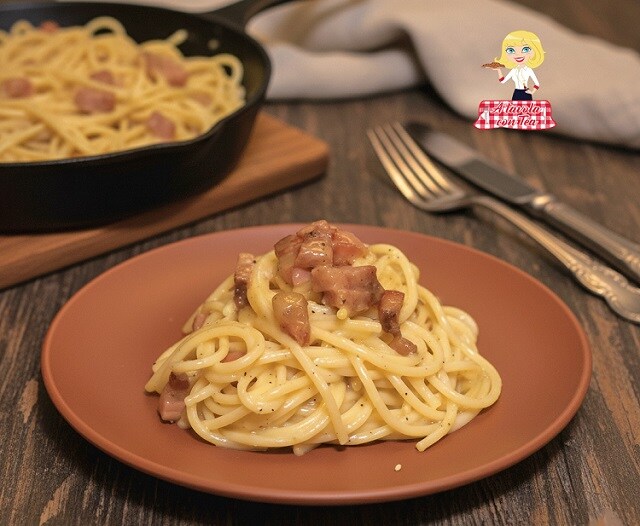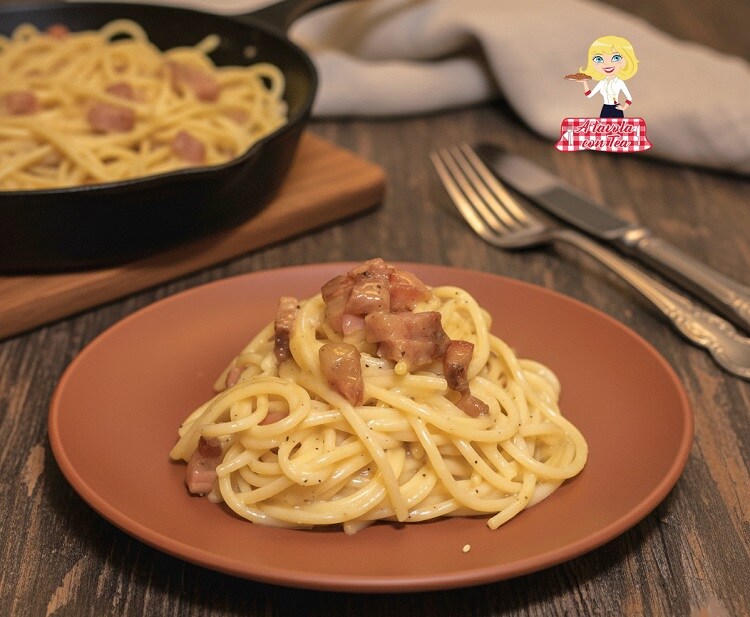PASTA alla CARBONARA
On April 6th of this year, for cooking and food lovers, it will be an “important” date: the Pasta alla Carbonara Recipe turns 70!
This date has long been dubbed the CARBONARA DAY, a day to celebrate this famous dish amidst skillet battles, wars between purists and innovators, “NO pancetta, YES guanciale” committees, only yolks or whole eggs, cream or no cream, spaghetti or rigatoni…
This recipe, in case you haven’t figured it out, has always been a source of discussion because everyone claims their version, everyone agrees when it’s celebrated but divided when it comes to making it.
For this year’s celebrations, I was chosen along with other bloggers to honor this renowned dish that the whole world envies us for: 70 food bloggers for the 70 years of Pasta alla Carbonara will post video recipes for the entire week dedicated to the celebrations.
Honored by this assignment, today I propose the Pasta alla Carbonara Recipe that, at least in the choice of ingredients, tries to be as traditional as possible: guanciale, DOP Pecorino Romano, eggs, freshly ground pepper.
How do I differ from the original recipe? In the pasta shape, for this special occasion, I deliberately chose a Heart shape, and I hope the Romans won’t crucify me for this poetic license.
But how does the magic of carbonara come about? The secret to a perfect result, that is, a creamy Carbonara where all the ingredients are perfectly combined without creating a scrambled egg effect, is to first create a balanced cream of yolks, cheese, and pasta cooking water, followed by other small tricks that I will reveal to you throughout the procedure.
Follow me and you will cook one of the best PASTA alla CARBONARA dishes you have ever made: creamy, enveloping, and full of flavor!
Other iconic recipes of Italian tradition

- Difficulty: Easy
- Cost: Medium
- Preparation time: 15 Minutes
- Portions: 4
- Cooking methods: Stovetop
- Cuisine: Italian
- Energy 676.01 (Kcal)
- Carbohydrates 24.86 (g) of which sugars 0.45 (g)
- Proteins 21.43 (g)
- Fat 54.00 (g) of which saturated 18.43 (g)of which unsaturated 22.31 (g)
- Fibers 1.57 (g)
- Sodium 1,601.30 (mg)
Indicative values for a portion of 100 g processed in an automated way starting from the nutritional information available on the CREA* and FoodData Central** databases. It is not food and / or nutritional advice.
* CREATES Food and Nutrition Research Center: https://www.crea.gov.it/alimenti-e-nutrizione https://www.alimentinutrizione.it ** U.S. Department of Agriculture, Agricultural Research Service. FoodData Central, 2019. https://fdc.nal.usda.gov
Ingredients
- 11 oz pasta (spaghetti or rigatoni)
- 7 oz guanciale
- 3.5 oz pecorino romano (dop)
- 4 pasteurized egg yolks
- 2 eggs (whole pasteurized)
- to taste black pepper
Tools
- Bowl
- Pan
- Pan
Before proceeding
IMPORTANT. To safely consume carbonara, use only pasteurized eggs. You can buy pasteurized yolks or pasteurize them at home (see the NOTE at the end of the recipe for the Egg Pasteurization method).
Carefully clean the guanciale by removing all the rind, scraping away part of the pepper with a knife blade. Cut it into slices about 0.4 inches thick and then into 0.4-inch cubes. Toast the guanciale in a very hot pan over high heat, WITHOUT oil or butter. Wait without stirring until the first fat is melted, then lower the heat, stir, and let the fat melt completely. The guanciale should become crispy (it will take about 15 minutes). Drain the guanciale, keeping the melted fat in a bowl and the cubes on a plate, and let them cool.
For egg PASTEURIZATION see note at the end of the recipe.
Once the eggs are pasteurized, put the yolks and whole eggs in a bowl and beat them with a fork or hand whisk. Add the cooled melted fat of the guanciale, a generous grind of black pepper, and finally the grated pecorino. Mix everything well with the fork: it should become a thick and homogeneous cream.
Meanwhile, cook the pasta in plenty of water, not too salty since the seasoning is already quite savory. Midway through cooking, take out two ladles of cooking water and put them in a bowl to cool; you will need them later to blend the pasta (the water should be taken out halfway through cooking to give it time to cool, otherwise it would create a nice omelet when in contact with the eggs!). Drain the pasta al dente.
Pour the reserved pasta cooking water into the bowl with the egg cream and mix quickly. Transfer the just-drained pasta into the bowl with the dressing and mix quickly with a spoon. Add the warmed guanciale and mix again. It is important to carry out this operation quickly to prevent the yolk from setting and becoming the consistency of scrambled eggs. Serve immediately on hot plates.
REMEMBER: The magic of a perfect carbonara is all in this challenging minute of emulsifying the eggs, cheese, and guanciale fat with the cooking water and the pasta’s gluten.

CHOICE OF INGREDIENTS AND MISTAKES NOT TO MAKE
GUANCIALE: For the traditional recipe, pancetta or bacon should not even be considered; that said, even the choice of guanciale is important. First, buy it in one piece, not already cubed or sliced. Ideally, the guanciale should be about the same weight as the pasta (for example: 200 g of pasta = 200 g of guanciale). Remove the rind and scrape off part of the spices (pepper and seasonings) on the surface as they may make the dish too salty. Then cut the guanciale into cubes about 0.4 inches.
Pecorino Romano DOP: it is an essential ingredient with its typical rustic and salty taste.
YOLKS: In this recipe, I used 4 yolks and 2 whole eggs for 4 people, I know it seems like a lot but I assure you that they are needed. If you don’t buy pasteurized eggs, you can pasteurize them at home by simply whisking them in a bowl over a bain-marie, being careful that the egg temperature does not exceed 140°F/149°F otherwise it could curdle.
TYPE OF PASTA: Whatever shape you choose, make sure to use high-quality pasta, you can opt for Spaghetti or Rigatoni, preferably bronze-drawn and that holds cooking perfectly.
PEPPER: Black or white pepper! Freshly ground on the plate, or added to the eggs.
MISTAKES NOT TO MAKE:
To make your carbonara richer, there is NO need to add cream! Simply add a little pasta cooking water, rich in starch, and you will achieve the right consistency.
NEVER add the egg sauce to the hot pan or even worse to the pan on the fire, otherwise all your efforts will go up in smoke, and you’ll end up with a scrambled egg effect!
HOW TO PASTEURIZE EGGS
PASTEURIZATION is the process that allows the reduction of bacteria present within raw eggs: those of salmonella. It is an essential procedure for those who want to make carbonara, but also all other types of recipes with raw eggs like tiramisu. It’s important to know that egg pasteurization does not alter its characteristics but simply allows them to be used safely.
How to pasteurize whole eggs
Heat the eggs in a bain-marie at a temperature of 149 degrees Fahrenheit for about 5 minutes. Then the eggs must be immediately cooled by putting them in the fridge until the moment of their use.
How to pasteurize only the yolks
In the case of carbonara, it is necessary to also pasteurize only the yolks. To do so, simply add two to three tablespoons of warm water (it’s fine to use the water in which you will then boil the pasta) to the yolks and pasteurize them in a bain-marie at 140 degrees Fahrenheit, slightly whisking them with a whisk for a couple of minutes. At this point, even the yolks are ready for use
VARIANTS (only one allowed!)
TYPE OF PASTA For the type of pasta, in addition to the classic spaghetti, you can also use rigatoni or mezze maniche. I, just for today forgive me, for this special birthday of the recipe I let myself go with the “heartbreaker” shape.
STORAGE
Pasta alla Carbonara must be consumed immediately. Any form of storage is not recommended because if you have to reheat it, the egg would cook!

